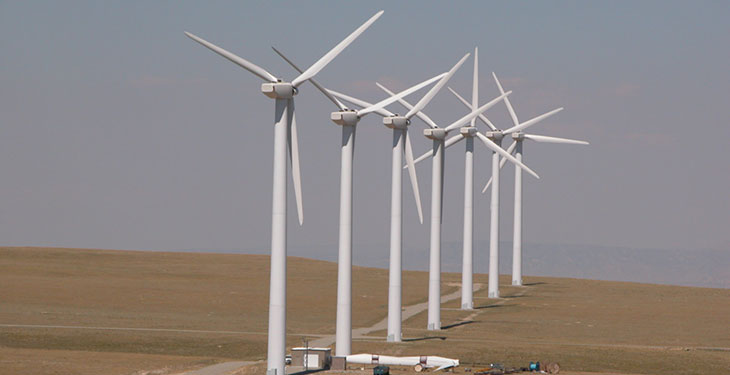Offshore wind power has a major role to play in Europe’s goals to reduce dependence on fossil fuel imports and decarbonization by 2050, at a time when the European Union’s (EU) interests in energy security and climate goals are aligned. The same principle is also valid for Romania, which would need the development of 15GW of offshore wind energy capacities in the Black Sea, i.e. the exclusive economic zone (EEZ), in order to achieve climate neutrality by 2050, according to a modeling exercise by Energy Policy Group (EPG). This would become the country’s largest source of electricity production, accounting for more than 40% of the total. The development of offshore wind farms takes between five and ten years, with an EU average of seven years, which reveals that there are major opportunities for Romania to connect the first offshore wind energy capacities to the electricity transmission network before 2030, according to the EPG.
Thus, Romania’s current status as a net importer of electricity could change, providing additional clean energy needed for the decarbonisation of sectors such as industry, transport and heating and cooling, according to the report Offshore wind – the enabler of Romania’s decarbonisation, released by EPG.
The authors of the report claim that addressing the challenges related to the electricity transmission networks faced by both Romania and Bulgaria in implementing the potential of offshore wind energy can be achieved through the Romanian-Bulgarian Energy Island concept (RO-BG).
”This would be an effective solution for unlocking the development of offshore wind energy at the level of economies of scale, as well as for expanding the interconnection capacity with other countries in the Black Sea basin (such as Turkey, Georgia, as well as Azerbaijan, to the East), which will contribute to energy security and price stability in the region. This will increase the offshore wind energy potential of the entire Black Sea basin, and the recently announced HighVoltage Direct Current (HVDC) submarine cable to be built by Romania, Azerbaijan, Georgia and Hungary will be an important pillar in this process.
“The average cost of energy production (LCOE) offshore based on fixed turbines will be of 71 euros/MWh in the Romanian area of the Black Sea basin, according to EPG’s realistic scenario for 2030, while for the further development of offshore wind energy on based on floating turbines, the LCOE would be of 94 euros/MWh. For a joint project between Romania and Bulgaria, including the costs of an HVDC connection at the Constața Sud station, as indicated in the reference scenario for wind energy based on fixed turbines, would lead to a total LCOE of 79 euros/MWh for an installed capacity of 3GW. Moreover, the realization of an energy island (Energy Island), RO-BG would lead to a total LCOE in the amount of 85 euros/MWh, assuming that the investment for the development of the island is divided equally between the two states. The total capital costs (CAPEX) allocated by Romania in a RO-BG Energy Island project, including the 3GW offshore wind farms, were estimated at 8.4 billion euros (810 million euros representing Romania’s part of the RO-BG Energy Island), while the annual energy production the result was estimated at 9.8TWh.”
In addition to the importance in the production process of green electricity, the development of offshore wind farms generates socio-economic benefits by creating jobs in the production, construction and operation and maintenance (O&M) of the projects, with a multiplier effect on other sectors, including by concentrating the economic activities associated with offshore electricity in the Port of Constanța. For 1GW of installed capacity, offshore wind power in Europe generates 2.1 billion euro. Consequently, 3GW of installed capacity of offshore wind energy in Romania could generate 6.3 billion euros, respectively 2.6% of GDP in 2021. Moreover, investments in 3GW of offshore wind energy could create a total of 22,000 new jobs for full-time employees (20,000 in the CAPEX phase and 1,800 in the operation and maintenance phase), of which 15,500 new jobs could be created directly at the national level, assuming that Romania would attract investors in the production of wind turbine components, in the construction, installation and maintenance of offshore wind farm infrastructure respectively, the report also states.
“Establishing an appropriate legislative and fiscal framework is essential in the development of offshore wind energy, in the current context marked by the accelerated expansion of these production capacities worldwide. A European Union dialogue on the objectives regarding the development of offshore wind energy in the Black Sea would facilitate the process for the two member states (Romania and Bulgaria), as well as for partners outside the EU. Furthermore, it could promote investments in Energy Islands as well as potential long-distance interconnections. From the perspective of the legislative and regulatory framework, this report proposes a mix of policies between a centralized, state-based model and an open process, based on investors, for the development of Romania’s area of the Black Sea basin, with the aim of capitalizing on the mentioned advantages and reducing the risks associated for investors. The permanent and consistent dialogue between authorities and investors is a pre-condition for the successful planning and development of offshore wind farms in Romania’s Black Sea area,” the authors claim.
